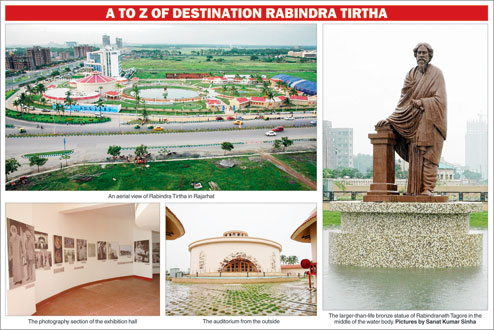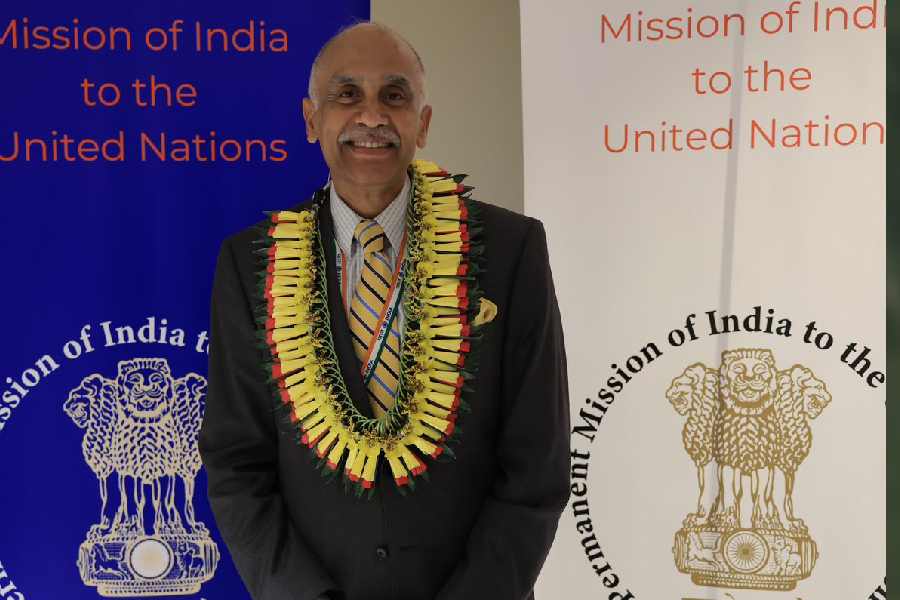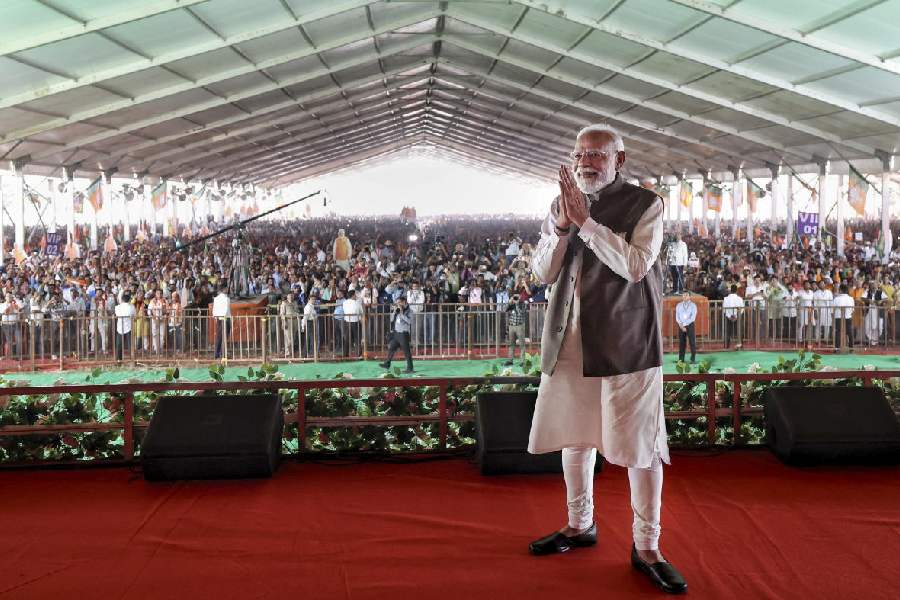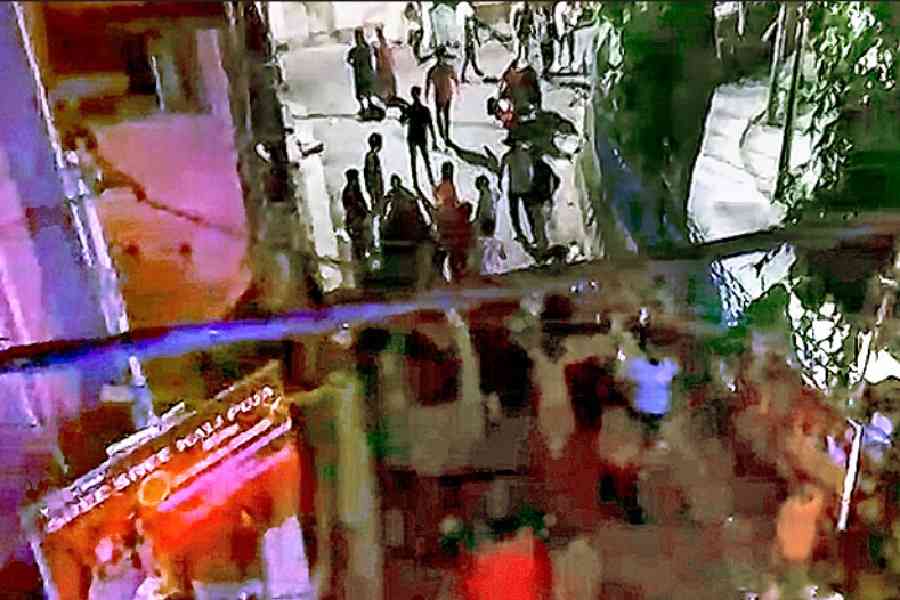 |
Rabindra Tirtha, the mammoth cultural complex that has come up in Rajarhat dedicated to promoting the works of Rabindranath Tagore, had its first task force meeting recently to chalk out a way ahead before it starts functioning from September 15. Metro takes a walkthrough…
Vital stats: The Tagore research centre is spread over five acres at New Town, Rajarhat. It was built in 291 days on a budget of Rs 30 crore.
Date of birth: The idea of Rabindra Tirtha was the Buddhadeb Bhattacharjee government’s in 2009. The fine-tuning and construction, however, was done in 2011.
“It was being planned in Rajarhat. We needed infrastructure and there were talks of the central government also contributing,” said Debashis Sen, principal secretary, urban development department, and the chairman of Hidco. “But since that didn’t happen, Hidco did everything on its own as instructed by the chief minister. You can call it a homage by the present government to Tagore on his 150th birth anniversary. The project was announced last Baishey Shrabon by chief minister Mamata Banerjee when she gave the public a picture of what was being planned. It was ready by this Baishey Shrabon. We did everything at breakneck speed.”
The concept: A research centre dedicated to the life and works of Tagore where scholars, researchers, students and enthusiasts can come together.
“It is not meant to be a Rabindra Sadan Part II but a mini-Santiniketan, a space for Rabindra-premis who want to think, study, research and experiment with Tagore’s works,” said Sen. “Spreading awareness and connecting with youngsters is high on the agenda.”
Rabindra Tirtha also plans to start certificate, appreciation and familiarisation courses on the poet, which would be devised “in consultation with Rabindra Bharati University”.
Experts panel: There’s a task force headed by urban development minister Firhad Hakim. Its members include Jogen Chowdhury, Shuvaprasanna, Joy Goswami, Dwijen Mukhopadhyay and Shaoli Mitra. Debashis Sen is the committee secretary.
The look: The theme of the compound is gram Bangla (rural Bengal) and mud houses and features wide open spaces. The oval-shaped complex near the Hidco Bhavan is dotted with red-tiled cottages in earthy colours, green patches and coconut groves circling a large water body, where there’s a huge statue of the poet.
Rabindra Tirtha tries to recreate a rural environment. To evoke the spirit of Santiniketan, even the flowers planted have been carefully chosen from those that find mention in Tagore’s works.
The pathways were originally made with red earth but floor tiles were placed after spells of rain created mud and slush pockets.
Central auditorium
What we saw: A neat dome-shaped 200-seater auditorium with cushioned chairs, blue velvet soundproofing on the walls and a carpeted floor sloping towards a “disproportionately large stage” that Sen explains has been purposely built in a way to facilitate “experiments with various audio-visual forms. With innovative lights and a state-of-the-art sound system in place, the auditorium is set to host dance and musical programmes on Tagore, lectures and demonstrations.
What to expect: Their first cultural show, comprising three Tagore dance-dramas, is on September 15. “We’re talking to local theatre groups and artistes to zero in on some performances to be staged,” said Sen.
Exhibition Hall
What we saw: Divided into two chambers, one houses replicas of ink and poster colour paintings by Tagore and the other has laminated photographs of Tagore at various stages of his life with family and friends. “One room will be developed like a museum with display cabinets and tables with Tagore’s handwritten material and items, including a replica of his Nobel medal,” Sen said.
What to expect: “We have plans to improve it, bring in furniture, add archived books and items for permanent display,” explained Sen. “The information and cultural affairs department will facilitate exhibitions on Tagore’s views on education,” he added.
Film archive and cinema
What we saw: Masons putting finishing touches to the kidney-shaped chamber. The cinema lay vacant.
What to expect: Private audio-visual rooms that can accommodate 30. All the films and documentaries made on Tagore are meant to be archived here and made available for screening, research and experimentation. “The information and cultural affairs department will lend documentaries on Tagore for screening,” said Sen.
Music archive, art gallery and library
What we saw: Two chambers facing each other, workers busy with electrical fittings and wiring arrangements in the chamber that will house an online archive and library.
What to expect: A personalised music room that can seat up to 50 people. “It will have state-of-the-art music equipment and the finest acoustics,” Sen said.
Dormitories and guest cottages
What we saw: Cottages for students and guest lecturers with a total accommodation capacity of 80. The installation of furnishings was being done.
What to expect: Cottages with wood-and-steel finish furniture. There’s everything for a comfortable stay for a few days: dining tables, sofas, wrought-iron beds and almirahs. The windows open out on the green stretches.
Tagore’s statue
What we saw: A 13-foot-high statue of the poet in bronze towering over the water body greets visitors. Its positioning —in the midst of water — signifies “Tagore is easy to see and understand yet very difficult to reach. You have to see it figuratively,” Sen explained.
What to expect: A barge will be a constant feature on the water. “We felt a barge and water body were essential to the core spirit of the place. Water in various forms, whether rain or river, and barges play an important part in Tagore’s stories and songs. So this was deliberately excavated and shaped to give the centre a pleasing feel,” added Sen.
Cafeteria and tea stall
What we saw: Two pillared sheds with a green patch and garden benches, yet to be filled in by a vendor.
What to expect: Think Nandan, think City Centre and that is what you can expect to take shape. “We want it to be on those lines where people feel free to come, sit, think and engage in interesting conversation over tea and coffee,” assured Sen.
Access
An entry fee of Rs 10 will provide access to visitors from September 15. If their primary target is the “serious and dedicated” group of scholars, researchers, students and performing artistes, they are also aiming at school students and their parents as well as tourists in order to get “casual or lay visitors interested in the phenomenon called Rabindranath and his works”.
Another aim is to engage youth from all over the world, including the Bengali diaspora, who can enrol and get access to a digital database that will be made available on the Internet. “There will be digital archiving accessible on the Web. We’ve seen that people today are very dependent on YouTube for a dance or music forms that they want to get their hands on while working on small-scale programmes in various paras. We want to create videos by various exponents of Tagore dance, music and poetry and make them available for streaming so that the authentic forms are disseminated and add value to the functions of Rabi Tirtha. Whether we will host it on YouTube or a specific website will be decided later,” Sen said. The authorities are looking at both direct and online subscriptions.
Care and maintenance
Will be outsourced to a private agency on annual contract. “It’s very difficult for government bodies to keep track of faults and need for repair work. We know the pains of petty maintenance, so we’ve decided to hire an agency to look after security and maintenance. We hope it will keep Rabi Tirtha in good shape,” said Sen.
Next in line
Nazrul Tirtha, which will be built on a similar concept on a two-acre plot adjacent to the DLF Building in Rajarhat. “The foundation stone was laid on Nazrul Jayanti on May 25 and the architectural design is presently being re-thought. We plan to get started on construction after Durga Puja, once the rains subside,” Sen said.
Would you like to visit Rabindra Tirtha? Tell ttmetro@abpmail.com










